The red showy flowers or the floral glories of Israel
Nitzanim, Flower buds, ניצנים: Anemones, tulips, Asiatic ranunculi, and poppies.
In the Jewish calendar Nisan is the seventh month of the civil and first of the religious year, usually coinciding with parts of March and April.
The month Nisan has three names. The first is Chodesh haRishon , the first month, so called to mark the time we became a people (The Jewish New Year, Rosh haShanah, in Tishrei , marks the creation of the world).
The month is also called Chodesh heAviv, the month of Spring.
And Nisan may be related to nitzan, bud. As King Solomon wrote in
the Song of Songs 2:12:
שיר השירים
הַנִּצָּנִים נִרְאוּ בָאָרֶץ עֵת הַזָּמִיר הִגִּיעַ
וְקוֹל הַתּוֹר נִשְׁמַע בְּאַרְצֵנוּ
ha'nitzanim nir'u ba'aretz
Eit hazamir higi'a.
The buds/flowers appear on the earth,
the time of singing has come,
and the voice of the turtledove
is heard in our land.
According to M.Zohary in Arabic Nissan is a whole group of plants with handsome red flowers.
These species do not bloom coincidentially but sequentially, beginning with the Anemones, and followed by the tulips, Asiatic ranunculi, and poppies, which spans the whole of spring - the red showy flowers or the floral glories of Israel.
These flowers have a similar appearance in shape and colour and from a distance they may easily be confused.
Anemone (Anemone coronaria) is traditionally identified as the `lily of the field'.
It is a widespread herbaceous perennial plant growing to 20-40 cm tall (rarely to 60 cm), with a basal rosette of a few leaves, the leaves with three leaflets, each leaflet deeply lobed.
The flowers are borne singly on a tall stem with a whorl of small leaves just below the flower; the flower is 3-8 cm diameter, with 5-8 red, white or blue petal-like sepals.
Recent research in Israel has shown that there is a genetic basis for this variation which explains for the dominance of a certain colour in a particular region. Around Jerusalem, for instance, the red shape is more frequent than the blue, while on the basalt slopes north the Sea of Galilee the hillside are speckled with the blue and white flowers.
The petals of the Anemone are usually nectariferous near the base, and in Ranunculus there is a flap of tissue in this position, a presence of reflexed sepals. The Asiatic Ranunculus, or buttercup (Ranunculus asiaticus), is also red-flowered.
Tulipa agenensis, Tulipa Montana (mountain tulip) and Tulipa Sharonensis.
A tulip is a flower with 5 petals, all intertwining, and without which, it would not make up a complete flower.
Its narrow, grey-green leaves are usually crinkled along the edges.
Corn poppies (Papaver rhoeas, Papaver subpiriforme etc.) are annuals inhabiting disturbed ground and their seeds are in capsules, unlike the anemone and ranunculus, which are perennials and have their seeds in separate nutlets.
Pheasant's eye (Adonis cupaniana, A. aleppica) are also annuals with scarlet flowers, but with nutlets like the anemone.
The “Red Anemone Guild Flowers” comprises some of the species from six plant genera
(Anemone, Tulipa, Ranunculus, Adonis, Glacium and Papaver) that belong to three
phylogenetically distant families (Ranunculaceae, Liliaceae and Papaveraceae).
Flowersof this guild are characterized by large, red bowl-shaped petals that surround a large
black mass containing the anthers and the female reproductive organs.
The flowers are insect-pollinated, and offer only pollen as food reward to visitors. The uniqueness of the
red anemone guild species is due to the rarity of large red floral displays among the
congeners of the guild members, as well as in the Mediterranean flora (Shmida 1981;
Dafni & Shmida 1989).
The pollination of the "Red Anemone Guild" is by Glaphyrid beetles (Scarabaeoidea).
Three Sisters, an Israeli Fairy tale
Once upon a time, in a far country, there lived a handsome prince.
After years of dissipation and tumultuous bachelorhood the prince decided to take a woman in his life, and announced that he would give an evening of “Speed Dating”, free and open to the female audience.
Hundreds of women decided to try their luck, including the Three Sisters: Anemone, Scarlet Crowfoot (Ranunculus) and Poppy.
On the appointed day the sisters (like most invited) stormed the nearby mall to get the most up to date garment and the most impressive accessories. The mall was full of women pushing and shopping to get an outfit. Within minutes the sisters had lost each other and only met again when they returned to their homes, each with the result of her shopping frenzy, all with the same red dress.
Trouble!? How could the Prince distinguish between the three?
After the tears, the blood returned to their faces, and they found a solution: each of them would add a rather unique accessory to her red dress.
Anemone added a white scarf she brought from her travels in India.
Scarlet Crowfoot, the trendy, added a green belt, decorated her dress with glitters and put on glossy lipstick.
Poppy wore a black beaded necklace around her neck.
With the upgraded performance they entered the hall and seized the prince's heart within minutes. He spent an entire day with every one of them, and after three days he admitted he could not reach a decision. The three sisters were also captured by the prince’s charms, and each wanted him for herself.
Wow, and another solution was found: the Prince would marry the three of them, on condition that once a year, every year, he will dedicate a period of time with each one separately.
The Prince in love quickly agreed, and only asked the sisters to continue to wear their special accessories to avoid unnecessary confusion and shame. For the same reason he also decided to open a log book and to set dates for each sister, in alphabetical order –
Anemone, Scarlet Buttercup, Poppy. Since then, every year, Anemone is the first to bloom, with a white scarf around the stamens,
Scarlet crowfoot with the bright shiny leaves and the typically green sepals enclosing the petals in the form of a belt, is the second to appear and
Poppy finishes the cycle, with dark circles on the petals.
So now you can distinguish the difference between an anemone and poppy.
|
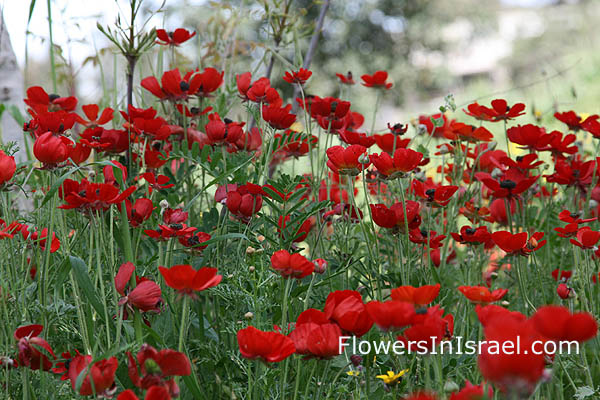 Red Showy Flowers
Red Showy Flowers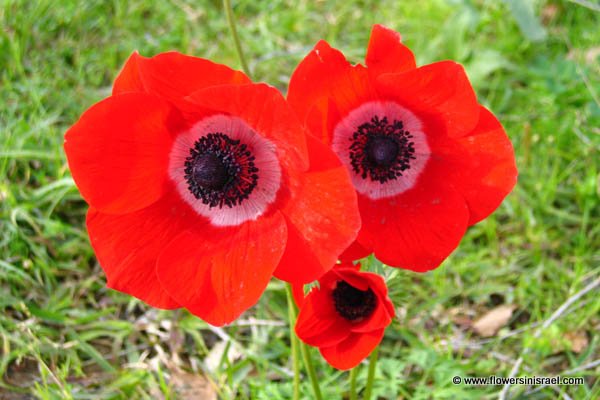 Anemone coronaria
Anemone coronaria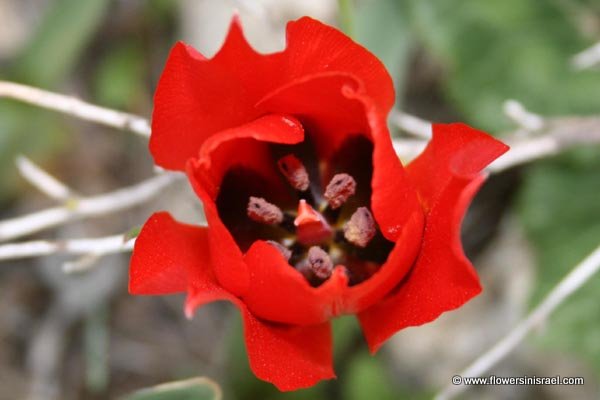 Tulipa agenensis
Tulipa agenensis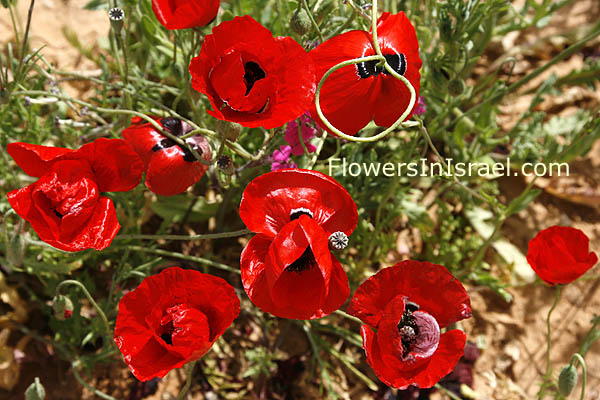 Papaver
Papaver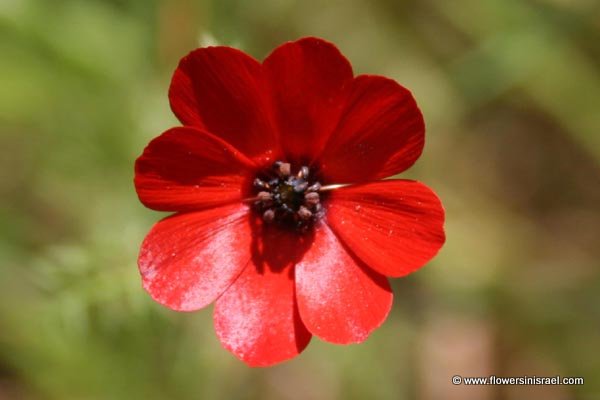 Adonis
Adonis